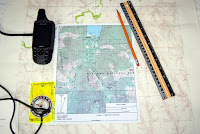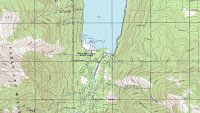Topographic map users are familiar with the small diagram at the bottom of the map.
The diagram is located at the bottom center of the map.
Let’s zoom in to the diagram itself.
Let’s discuss what that all means.
The line on the left with the star on top is the reference to true north. True north is the principle geographic reference on all maps. True north is oriented to the North Pole, the top of the earth. The left and right borders of a topographic map are aligned to true north too. True north is the principle compass orientation that the backcountry traveler will use with compass navigation.
Care should be taken when looking at the other grid lines on a map. For example, not all township and range lines are oriented to true north. The red lines on the map below
represent township and range. The red numbers refer to each of the 36 sections found in a township. (A section is a square that is one mile by one mile on each side.) Determine if these red line are oriented to true north in advance of your trip.
The next line over is “grid.” Grid in this case refers to Universal Transverse Mercator Grid (UTM). UTM is a derivative of the military’s grid reference system and came about after World War Two.
Some maps come with UTM grid lines laid out in a shade of light blue. Many topographic maps only have UTM tick marks (color blue) along the four sides of the map. The map above has those tick marks. Small they can be seen as numbers 6 21 and 6 22 at the bottom. If one was to use a straight edge to connect the 6 21 at top and bottom the line drawn would be in relation to grid on the declination diagram. (For more information on UTM Grid check out Lawrence Letham’s book GPS Made Easy from library.)
The last line refers to magnetic north. This data is circled in red (below.)
To keep things simple, I use a declination adjusted compass so that I do not have to calculate compass values. For example, if the hiker is using a standard compass, 19° East declination (from the West Coast) would be subtracted from a bearing/azimuth of 100° True to get the correct magnetic heading. This gets a bit sticky and that is why an adjustable compass is so valuable. With an adjustable compass, you adjust the compass housing once for the local declination. Once adjusted you are set and won’t need to worry about adding or subtracting the declination value.
The declination value on older maps has probably changed from what is printed. Declination changes over time. As a matter of routine I visit www.magnetic-declination.com to get the correct value before leaving home.
The north star
The north star
















